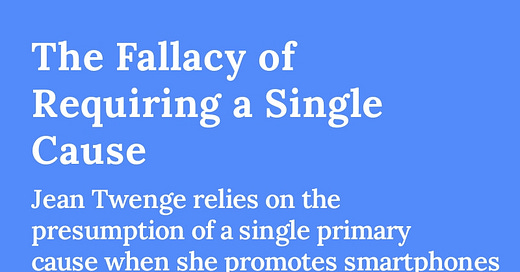The Fallacy of Requiring a Single Cause
Jean Twenge relies on the presumption of a single primary cause when she promotes smartphones proliferation as the main cause of several adolescent mental health trends.
Jean Twenge posted last month an article titled Yes, it’s the phones (and social media) that was recently reposted by Jon Haidt on his Substack as Here are 13 Other Explanations For The Adolescent Mental Health Crisis. None of Them Work.1
In her article, Twenge declares “I’ll consider 13 alternative explanations for the increases in teen depression, loneliness, and suicide since 2011” and rejects each of them.2
Multiple Trends
Twenge seeks an explanation of multiple adolescent trends ranging from affects such as loneliness to disorders such as depression and anxiety and non-fatal self-harm to completed suicide.
These trends, however, have distinct scopes and timing.
On one hand, there is evidence that loneliness and school alienation has increased globally among students (see The Perils of Improper Terminology); on the other, there seems to be no such evidence for disorders and suicide — the best I’ve seen so far are substantial increases in most Anglo-sphere countries and Scandinavia.
Regarding disorders and suicide, there are considerable differences in the timing of the rises in the U.S. — youth suicide starting to increase in 2008, 4 years ahead of disorders, and ceasing to increase in 2018 while disorders continue to rise (see The Trouble with Suicide).
There is no doubt that trends in affects, disorders, and suicide might be strongly linked at times, but I’ve seen no evidence that they always have to be linked strongly and indeed available evidence counters this notion.
Presumption of a Single Cause
Unfortunately Twenge dismisses any single factor unless it can be the primary cause of all these trends — a requirement that Twenge never justifies.
Furthermore, even a single trend need not have any primary cause at all — it could be the result of the interaction of several major factors, none of them dominating overall.
For example, the pandemic is obviously unable to explain any trends before 2020, but that does not mean it could not be a major cause of problems after 2020.
The Great Recession could have played a major role in the adolescent suicide rise between 2007 and 2009.
Academic pressure might have played a substantial role at various stages of some mental health trends in the U.S. while international rises in school alienation could be partly the consequence of many nations emphasizing student testing in schools.
Childhood trauma due to adult suicides within family — impacting especially kids who may be already the most vulnerable — might explain much of the U.S. teen suicide trends in the last half-a-century (see Childhood Trauma and Youth Suicide Rates).
And so on.
Flawed Argument
The subtitle of Twenge’s original post was
How every other explanation – from lack of independence to academic pressure to the pandemic – falls short
and the subtitle of the repost is
Only smartphones plus social media can explain the international collapse in the early 2010s.
The implication is clear: smartphones proliferation3 is the only explanation.
The major flaw in this conclusion is the exclusion of multi-factor causes of the various mental health trends under consideration.
Furthermore, smartphones proliferation does not explain the discrepancies in the timing of U.S. suicide and depression rises, nor does it explain why there appear to be no similar trends in disorders and suicide on a truly global scale (as there is with school alienation).
Conclusion
Recent trends in adolescent mental health ranging from affects to disorders to suicide may have been caused by a number of major factors, none of which needs to be dominant.




Well-said.